#symbolon
Explore tagged Tumblr posts
Text

You feel today that you are being swamped by a bombardment of information contradicting everything that you hold true to your heart. The information sounds compelling especially since it entices you to sacrifice personal responsibility for a more laidback approach of trusting others to understand what you want and bring it to you. Rest in the pure fantasy for the moment as it is a lot easier to waste the time than actually having to get your-self up and motivated
#Symbolon#divination#fortune telling#fortune teller#message for the collective#card reader#card reading#gay pagan
24 notes
·
View notes
Text
“One general description of madness, it seems to us, might be found in the statement that madness is a preference for the symbol over that which it represents. The most obvious example is the religious maniac, in whom the worship of Christianity involves the negation of all those ideas of integrity and mercy for which Christianity stands.
But there are many other examples. Money, for example, is a symbol; it symbolises wine and horses and beautiful vesture and high houses, the great cities of the world and the quiet tent by the river. The miser is a madman, because he prefers money to all these things; because he prefers the symbol to the reality.
But books are also a symbol; they symbolise man's impression of existence, and it may at least be maintained that the man who has come to prefer books to life is a maniac after the same fashion as the miser. A book is assuredly a sacred object. In a book certainly the largest jewels are shut in the smallest casket. But that does not alter the fact that superstition begins when the casket is valued more than the jewels. This is the great sin of idolatry, against which religion has so constantly warned us […]
Idolatry exists wherever the thing which originally gave us happiness becomes at last more important than happiness itself. Drunkenness, for example, may be fairly described as an engrossing hobby. And drunkenness is, when really comprehended in its inward and psychological reality, a typical example of idolatry […]
Now in this sense bibliomania is capable of becoming a kind of drunkenness. There is a class of men who do actually prefer books to everything with which books are concerned, to lovely places, to heroic actions, to experiment, to adventure, to religion. They read of godlike statues, and are not ashamed of their own frowsy and lazy ugliness; they study the records of open and magnanimous deeds, and are not ashamed of their own secretive and self-indulged lives. They have become citizens of an unreal world, and, like the Indian in his Paradise, pursue with shadowy hounds a shadowy deer. And that way lies madness.
In the limbo of the misers and the drunkards, which is the limbo of idolators, many great scholars may be found. Here, as in almost all ethical problems, the difficulty arises far less from the presence of some vicious tendency than from the absence of some essential virtues. The possibilities of mental derangement which exist in literature are due not so much to a love of books as to an indifference to life and sentiment and everything that books record.
In an ideal state, gentlemen who were immersed in abstruse calculations and discoveries would be forced by Act of Parliament to talk for forty-five minutes to an ostler or a landlady, and to ride across Hampstead Heath on a donkey. They would be examined by the State, but not in Greek or old armour, which are their pleasures, and in which they may be trusted as safely as children at cross-touch. They would be examined in Cockney dialect, or in the colours of various omnibuses. They would be purged of all the tendencies which have sometimes brought lunacy out of learning; they would be taught to become men of the world, which is a step towards becoming men of the Universe.”
— G.K. Chesterton: “Lunacy and Letters”
#the metaphysics of this! the ethics!#symbolon#g.k. chesterton#madness#idolatry#I am-as the kids say-shook#books and reading#reality
52 notes
·
View notes
Text

Spending some quality time with my Symbolon deck today – for those of you who may not be familiar with the deck, it was created by Peter Orban not as a divination deck, but as a tool for psychological exploration of the hidden personas of the subconscious, with an added dose of astrological content.
Given the fact that this year I am neck-deep in several Psychology and Astrology courses, it was the perfect time to revisit this beautiful deck, and go deeper into its many layers of meaning and magic. Decks need charging and feeding just as much as any other tool, so I dressed the table up a bit in its honour, and took some pictures for my archive.
2 notes
·
View notes
Text
Kártyák titkai: A Symbolon
Új blogot kezdek, amiben szeretnék Nektek bemutatni olyan kártyatípusokat, amik alapvetően nem játékkártyák, hanem valamilyen gondolati tartalmat hordoznak, utakat kínálnak fel vagy - mint esetünkben - egyfajta belső gondolkodásra késztetnek, ahogy az alkotók - Peter Orban és Ingrid Zinnel - fogalmaznak, az emlékezés játéka.
Azért választottam elsőként a Symbolont, mert a tarot kártyákat sokan ismerik, sokan - jól, rosszul - használják is és alapvetően a jövő útjait szeretnék kifürkészni.
itt azonban egészen másról van szó. A játék célja nem a jövő és a kinyilatkoztatás, hanem a múlt és az emlékeztetés. A kártya lapjai olyan szerepszemélyiségeket (archetípusokat) illetve léthelyzetket jelenítenek meg - Thea Weller csodálatos grafikáin keresztül - , amelyek mindannyiunk lelkében ott lakoznak és ezáltal alkalmasak terápiás célra. A kártyalapokon szereplő szerepszemélyiségek megjelenhetnek problémaként, a probléma megoldásához vezető útként vagy akár a probléma megoldásaként. A képeknek sajátos emlékeztető szerepük van, amely messze meghaladja az írott szó lehetőségeit. Az írott szó felejtést csepegtet a lelkekbe, mert az ember - az írásba vetett bizalma miatt - már csak a kívülről jövő idegen jelek (betűk) által tud emlékezni, nem pedig közvetlenül, belűlről. Így aztán az emlékezés kívülről jövő aktusság válik.
A képekre nem vonatkozik ez a korlátozás. Ezek közvetlenül lépnek kapcsolatba a lélekkel, megérintik és elvezetik a kérdéshez: mit jelent a lelkemnek ez a kép?

Tisztázzuk először is, hogy mi a symbolon fogalma. A symbolon olyan szó, amely egyidejűleg jelöl tárgyat és tevékenységet. Olyan tárgyat, ami egykor kettétört és részei szétszóródtak a világban. Régebben cserépedényt vagy tányért törtek ketté, hogy a két részt egymást nem ismerő embereknek adják, akik aztán elkezdik keresni a másik felet (manapság ilyenek a kettétörhető szív medálok).
Belátható, hogy nem könnyű a szimbólumokkal bánni. Nagy bátorság kell ahhoz, hogy a lelkünk mélyére alámerüljünk. De aki vállalja ezt, annak a kártyalapok évekig, évtizedekig mesélni fognak.

A lélek képekben és érzésekben él, hiszen a képek igazából megmerevedett érzések. A képek - hasonlóan a mesékhez, mondákhoz, mítoszokhoz - táplálják, erőssé és elevenné teszik a lelket. Ehhez olyan képekben elmesélt történetek kellenek, amelyek saját belső kincseinkre emlékeztetnek. A mélységből neked kell - akár egyedül, akár a segítségemmel - kiemelni őket. Neked kell elindulni a keresésre. Ilyen keresés vezet pl. minden házassághoz is és ezen az esetleges válás sem változtat, hiszen szakítás után mindkét rész újra kiegészülést keres.

A keresés lényege nem az eredmény, hanem, hogy elindulj. Nem a cél a fontos - hiszen az útközben változhat is -, hanem, hogy felkelj a fotelból és elindulj valahová, érezvén, hogy a symbolonnak csupán az egyik fele vagy. Ez az, amiben a kártya az emlékezéshez segítséget nyújt.
Az elkövetkező bejegyzésekben bemutatok majd Symbolon kártyalapokat, és némi segítségként leírom majd a laphoz fűződő gondolataimat is.
Ha gondolod, tarts velem az utazáson, ha pedig segítségre van szükséged, bátran keress meg.
0 notes
Photo

Symbolon Deck Symbolon Deck Cards – June 1, 1993 by Peter Orban (Author), Ingrid Zinnel (Author), Thea Weller (Author) --Brand New-- The imagery of this unique 80-card deck helps the reader uncover memories from deep within the soul for profound personal insights. Unlike oracle decks, Symbolon is designed for summoning the past rather than diving the future. The cards, which depict historical scenes from European daily life as well as mythological stories, can be used in two different ways to explore memories of the past. The cards can be interpreted with a purely psychological approach, which does not require any knowledge of Astrology. Alternatively, Symbolon can be used a remembrance tool using Astrology. Each possible astrological constellation in the horoscopes is illustrated by the cards as an expression of deep, spiritual activity. The booklet describes each card with both the psychological and the astrological meaning. In addition, each card is interpreted by one of three positions in a spread: as the problem, the way through the problem, or as the outcome. This 80-card deck uncovers the memories of the soul. Astrology, personal insights, and symbolism in daily life are revealed. Product details Cards: 78 pages Publisher: United States Games Systems (June 1, 1993) Copyright Date: 2010 Language: English ISBN-10: 0880797258 ISBN-13: 978-0880797252 Product Dimensions: 3.5 x 1.2 x 5.2 inches Shipping Weight: 9.6 ounces
0 notes
Text
The English word ‘symbol’ is the Greek word symbolon which means, in the ancient world, one half of a knucklebone carried as a token of identity to someone who has the other half. Together the two halves compose one meaning. A metaphor is a species of symbol. So is a lover. In the words of Aristophanes (in Plato’s Symposium):
ἕκαστος οὖν ἡμῶν ἐστιν ἀνθρώπου σύμ��ολον, ἅτε τετμημένος ὥσπερ αἱ ψῆτται, ἐξ ἑνὸς δύο· ζητεῖ δὴ ἀεὶ τὸ αὑτοῦ ἕκαστος σύμβολον.
Each one of us is but the symbolon of a human being—sliced in half like a flat-fish, two instead of one—and each pursues a neverending search for the symbolon of himself. (191d) Every hunting, hungering lover is half of a knucklebone, wooer of a meaning that is inseparable from its absence.
Anne Carson, from ‘Eros the Bittersweet: An Essay’
278 notes
·
View notes
Photo
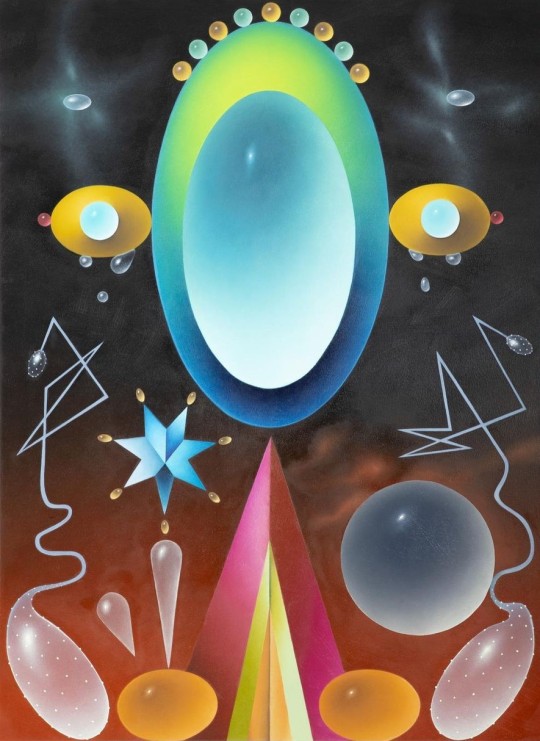
Alessandro Keegan (American, b. 1980)
Endless Symbolon, 2023
oil on canvas
196 notes
·
View notes
Note
so, could you find stuff that looks like what the demon on top of the pillar VII of the Chauvigny Saint-Pierre collegial church?

answer below the cut :)
hi! since you said 'demon' in singular i assume we're talking about the the squatting creature in the middle? (on wikipedia it says that this one is the devil, flanked by two demons.) i can't say that it reminds me of any particular demon/devil, but it also doesn't look atypical to me at all. demons/devils in medieval art come in all shapes, sizes and colours, and to my eyes this one just looks like another variation of the recurring 'themes' of demon depictions. here's the devil on another pillar of the same church:
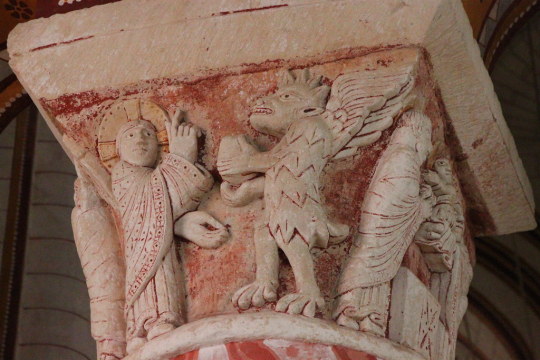
so, he seems to have fur, a tail, wings, some kind of claws or paws for feet, relatively human hands, spiked hair, spiky ears and a kind of half-human/half-animalistic face. all of those features are very common in the demon/devil depictions i've come across.
just as a random example, here are some demons from a 15th c. bavarian manuscript that share a lot of the same features:
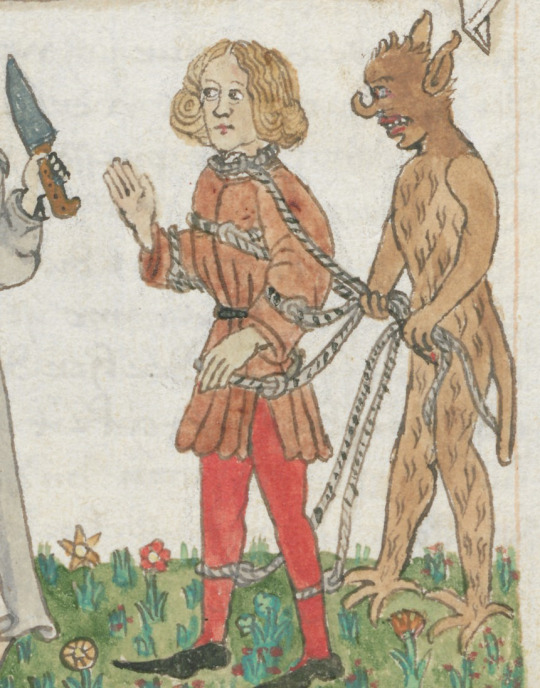
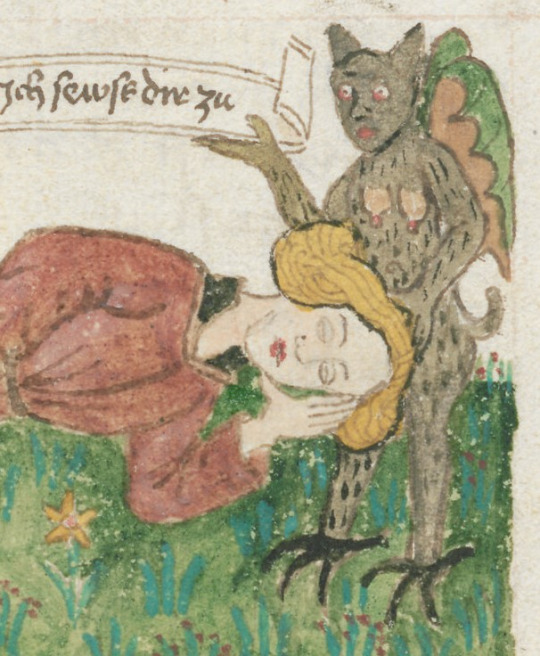
(Berlin, SBB, Hdschr. 300, fol. 2r and 26r)
same goes for these two:

(Paris, BnF, Français 22971, fol. 28v)
the squatting position as well as the facial expression kind of reminds me of this depiction of the devil in the 'livre de la vigne nostre seigneur' (france, c. 1450–1470):

(Oxford, Bodleian Library, MS. Douce 134, fol. 67v)
all of the illustrations shown above were created several centuries later than the (early 12th c.) saint-pierre pillars though, i should add. you would have to ask somebody else if you're interested in an art-historical classification of the st.-pierre devil.
EDIT: i focused on the devil's phenotype, but i just saw on your blog that you're actually interested in the x-shaped cross he's holding, which the (german) wikipedia article calls "a symbol of death, with a tilted cross and dots in the triangular areas". i also have a hard time finding other references to this "symbol of death" anywhere, but in this list of cross symbols the "schrägkreuz" (english wiki calls it "saltire, also called saint andrew's cross or the crux decussata") is said to have originally symbolized the crossed logs of a sacrifical altar (for fire sacrifices) and is thus found in depictions of the sacrifice of isaac and in depictions of the widow of sarepta/zarephath. there seems to be more information on it this in this lexicon:
Gerd Heinz-Mohr: Lexikon der Symbole. Bilder und Zeichen der christlichen Kunst, S. 177. Eugen Diederichs Verlag, München, Neuausg. 1998.
possibly also here? (also german, sorry)
Rickert, Arnold: Über Kreuz und Schrägkreuz als Figuren im Raum. In: Symbolon. Jahrbuch der Gesellschaft für Wissenschaftliche Symbolforschung Bd. 6 (1968) S. 56-71.
#demons#devils#ask#btw every time i answer any questions please keep in mind that i'm not an expert on any of this#saltire#saint andrew's cross#crux decussata
32 notes
·
View notes
Photo

Alessandro Keegan - Endless Symbolon, 2023
67 notes
·
View notes
Photo

You have all the equipment to make a positive change to a lack lustred relationship today even though actually sorting out where to begin is going to be tough and difficult. There are too many variables at stake in this relationship should you approach the task and person the wrong way. Today it seems that before you do anything carefully analyse if what you are planning to do will bring in a better connection and joy into the relationship or will it only create more burdens and compliancy.
#symbolon#symbolon cards#oracle cards#oracle deck#oracle card reader#oracle card reading#divination#message for the collective#fortune telling#fortune teller#gay pagan
48 notes
·
View notes
Text
The English word ‘symbol’ is the Greek word symbolon which means, in the ancient world, one half of a knucklebone carried as a token of identity to someone who has the other half. Together the two halves compose one meaning. A metaphor is a species of symbol. So is a lover.
vomits. Every time she brings literal Playing With Words wordplay into the "human experiences that give u the joys and pains of Desire" friendgroup i get jumpscared and lose my mind
11 notes
·
View notes
Text
Remember that the Symbolon Reading Special is still available until December 31 - if you are looking for guidance and vision from your Higher Self, this is the right reading for you!
0 notes
Text
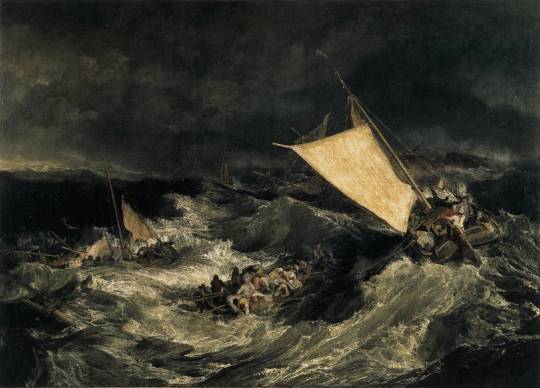
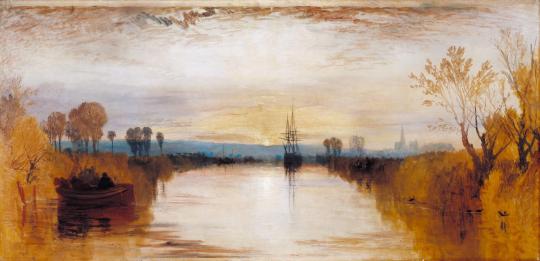
Da: SGUARDI SULL’ARTE LIBRO QUARTO - di Gianpiero Menniti
CUM NAUFRAGIUM FECI, TUNC BENE NAVIGAVI
Ossimoro latino, forse risalente a Zenone, riproposto da Erasmo da Rotterdam (1469 - 1536) nel suo “Adagia”, 1500, (Centuria 1878) con questa formulazione:
«Nunc bene navigavi, cum naufragium feci.» «Posso dire di aver ben navigato, solo dopo aver fatto naufragio.»
Non si tratta di riferirsi al viaggio, ma al viaggio per mare, là, dove nessuna strada è tracciata e ogni rotta è possibile e ogni istante può mutare in tempesta.
Metafora drammatica.
Temuta.
Accettata.
Subita.
Agognata.
Come per ogni domanda profonda, solo portandosi fino all’estremo confine è possibile scorgere la luce della coscienza consapevole.
Così, la pittura di Turner, agli esordi dell’800, ha già nelle corde il vibrare della crisi di un secolo impetuoso, durante il quale sarà impossibile cambiare rotta per evitare la furia degli elementi.
La metafora diviene simbolo: la tempesta è la metà del piatto spezzato - σύμβολον (symbolon) - che indica l’origine e l’identità da ritrovare.
Essenza del pensiero “romantico” agli albori: esistere, è tragedia.
Il “dipinto-simbolo” racconta il senso, necessario, del vivere: prendere il mare aperto e ogni rischio che questo comporti.
Ogni rischio, anche mortale.
Pur di ricongiungersi con l’altra metà del piatto.
Rimasto ad attendere in un placido canale.
L’ossimoro, si compie.
- Joseph Mallord William Turner (1775 - 1851): “Il naufragio”, 1805, Tate Britain, Londra e “Canale di Chichester”, 1828, Tate Gallery, Londra


16 notes
·
View notes
Text

Quel che ho visto, udito, appreso...
Da Bachofen: che il mito è l'esegesi di un simbolo e che questa esegesi può avvenire solo in forma di racconto.. I nostri teologi, invece, sanno raccontare così poco, che hanno trasformato la novella di Gesù, così fantastica e lieve, in un symbolon, che per essi significa "credo" - cioè in un pacchetto di dogmi.
-Giorgio Agamben
2 notes
·
View notes
Text
I'm watching Symbolon: Pt 2: Session 5: Matrimony & Holy Orders: Service & Communion on FORMED.
http://watch.formed.org/videos/matrimony-holy-orders-the-sacraments-of-service-communion
Amazing video. So confirming of what I knew inside and felt in my heart.
Marriage must be free, total, faithful, and fruitful, reflecting Christ’s love for the church.
Who can enter into a sacramental marriage?
- Two baptized persons
- Opposite Sex
- People who are free internally & externally
Questions asked during the Rite of Marriage:
1. Have you come here to enter into Marriage without coercion, freely and wholeheartedly?
2. Are you prepared, as you follow the path of Marriage, to love and honor each other for as long as you both shall live?
3. Are you prepared to accept children lovingly from God and to bring them up according to the law of Christ and his Church?
A marriage should be a triangle, one of the strongest foundational shapes: Man, Woman, and God.
Ultimate Goal: getting you, your spouse, and your children into heaven.
This is totally good, beautiful, and true.
I will accept nothing less.
3 notes
·
View notes
Text
The English word “symbol” is the Greek word symbolon which means, in the ancient world, one half of a knucklebone carried as a token of identity to someone who has the other half. Together the two halves compose one meaning. A metaphor is a species of symbol. So is a lover. In the words of Aristophanes (in Plato’s Symposium):
Each one of us is but the symbolon of a human being— sliced in half like a flatfish, two instead of one— and each pursues a neverending search for the symbolon of himself.
Every hunting, hungering lover is half of a knucklebone, wooer of a meaning that is inseparable from its absence.
— Anne Carson, Eros the Bittersweet
4 notes
·
View notes